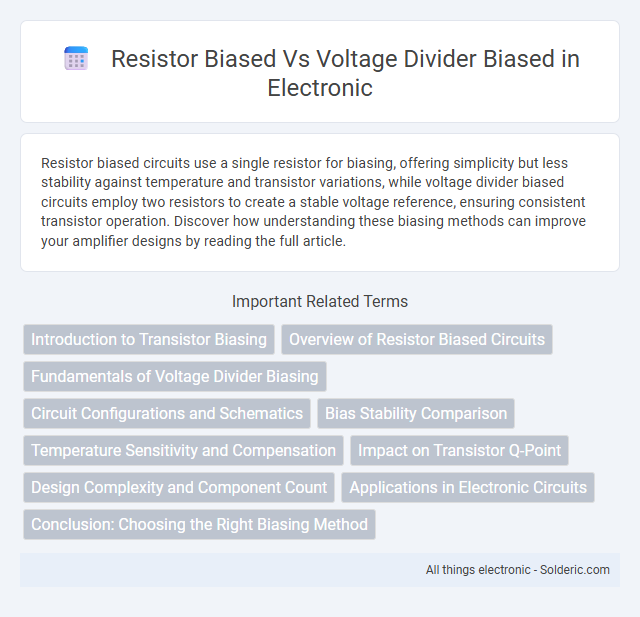Resistor biased circuits use a single resistor for biasing, offering simplicity but less stability against temperature and transistor variations, while voltage divider biased circuits employ two resistors to create a stable voltage reference, ensuring consistent transistor operation. Discover how understanding these biasing methods can improve your amplifier designs by reading the full article.
Comparison Table
| Aspect | Resistor Biased | Voltage Divider Biased |
|---|---|---|
| Configuration | Single resistor at base | Two resistors forming voltage divider at base |
| Stability | Low stability with temperature and b variations | High stability due to stable bias voltage |
| Bias Voltage | Depends on resistor and b (current gain) | Fixed by voltage divider network |
| Ease of Design | Simple but less reliable | More complex but stable operation |
| Application | Low-cost, basic circuits | Precision amplifiers and reliable switching |
| Effect of b Variation | Significant effect on bias point | Minimal effect on bias point |
Introduction to Transistor Biasing
Transistor biasing stabilizes the operating point to ensure consistent amplification. Resistor biased circuits use a single resistor to set base current, offering simplicity but limited stability against temperature variations and transistor parameter changes. Voltage divider biased circuits employ two resistors forming a stable voltage divider network, providing better bias stability and predictable transistor operation, making it ideal for your reliable electronic designs.
Overview of Resistor Biased Circuits
Resistor biased circuits use a single resistor connected to the base of a transistor to establish the operating point, offering simplicity and ease of implementation in low-cost applications. These circuits are sensitive to variations in transistor parameters and temperature, which can cause instability in the bias point. You may prefer resistor biased configurations for basic, low-frequency circuits where precise biasing is not critical.
Fundamentals of Voltage Divider Biasing
Voltage divider biasing employs two resistors connected in series across the supply voltage to create a stable and predictable base voltage for the transistor, ensuring consistent operating point despite variations in beta (b) or temperature. This method enhances transistor stability by fixing the base voltage through a voltage divider network, minimizing the effect of transistor parameter changes. The key fundamentals involve designing the resistor values to provide appropriate base current and maintain a reliable quiescent point, crucial for amplifier performance and linearity.
Circuit Configurations and Schematics
Resistor biased circuits use a single resistor connected to the base of a transistor to set the operating point, making the configuration simple but less stable against variations in temperature and transistor beta. Voltage divider biased circuits employ two resistors forming a voltage divider network to provide a stable base voltage, ensuring better bias stability and consistent transistor operation. Your choice between these configurations impacts circuit reliability, with voltage divider biasing preferred in precision amplification applications.
Bias Stability Comparison
Voltage divider bias offers superior bias stability compared to resistor bias due to its use of two resistors that create a stable voltage reference, minimizing variations caused by temperature changes or transistor parameter fluctuations. In contrast, resistor bias relies on a single resistor in the emitter circuit, which makes the operating point more susceptible to shifts, leading to potential distortion or cutoff. Your circuits benefit from voltage divider bias when consistent transistor operation under varying conditions is critical.
Temperature Sensitivity and Compensation
Resistor biased circuits exhibit higher temperature sensitivity due to variations in transistor parameters like beta, causing fluctuations in the operating point. Voltage divider biased configurations offer better temperature compensation by stabilizing the base voltage through a fixed voltage divider network, minimizing the impact of temperature-induced changes. Your choice between these biasing methods significantly affects circuit stability and performance under varying thermal conditions.
Impact on Transistor Q-Point
Resistor biased circuits exhibit a drifting transistor Q-point due to their reliance on a single resistor for biasing, making them sensitive to variations in transistor beta and temperature changes. Voltage divider biased circuits utilize two resistors to create a stable reference voltage, significantly enhancing Q-point stability by minimizing beta dependence and temperature effects. This stability ensures reliable transistor operation, improved linearity, and consistent amplifier performance across varied operating conditions.
Design Complexity and Component Count
Resistor biased circuits exhibit simpler design complexity with a minimal component count, typically involving just a single resistor for biasing. Voltage divider biased circuits require a more intricate design incorporating two resistors to establish a stable bias point and improve thermal stability. The increased component count in voltage divider biasing contributes to enhanced performance but at the cost of added design complexity.
Applications in Electronic Circuits
Resistor biased circuits are commonly used in simple, low-cost applications such as small-signal amplifiers and basic switching circuits due to their straightforward design and ease of implementation. Voltage divider biased configurations provide superior stability and are widely employed in precision analog circuits, including audio amplifiers and sensor interfaces, ensuring minimal variation with temperature or transistor parameter changes. The choice between resistor and voltage divider biasing directly affects circuit performance, with voltage divider bias dominating in reliable, high-performance systems.
Conclusion: Choosing the Right Biasing Method
Resistor biased circuits offer simplicity and cost-effectiveness but suffer from poor stability against temperature and transistor parameter variations, making them less suitable for precision applications. Voltage divider biased configurations provide superior stability and consistent operating points by using two resistors to set a fixed base voltage, ensuring reliable transistor performance even with fluctuating conditions. Your choice should depend on the need for stability and accuracy, with voltage divider biasing preferred for critical circuits requiring robust and predictable operation.
Resistor biased vs Voltage divider biased Infographic

 solderic.com
solderic.com